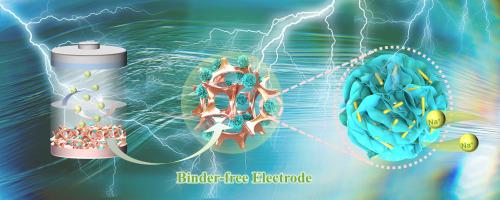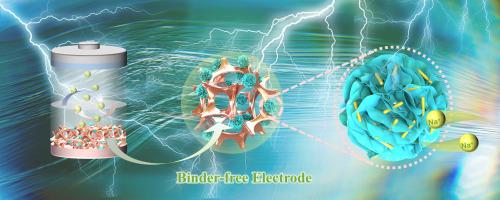由掺杂磷碳包裹的Cu2S纳米片/棒组成的分层结构作为先进钠离子电池的独立电极
IF 5.6
3区 材料科学
Q1 ELECTROCHEMISTRY
引用次数: 0
摘要
硫化铜(Cu2S)由于其成本效益、天然丰度和环境兼容性,已成为一种很有前途的钠离子电池(sib)阳极材料。然而,它的实际应用受到固有限制,包括导电性差和循环过程中严重的体积膨胀。为了解决这些挑战,我们通过环保的固体离子树脂辅助化学气相沉积(CVD)类策略,开发了一种新型的混合结构,由磷掺杂碳包裹Cu2S纳米片/棒和(P-Cu2S@C NSRs)组成,其中树脂同时作为双磷和硫前体。这种分层结构协同实现了三个关键功能:1)有效缓冲Cu2S体积波动,2)防止聚集,3)缩短Na+扩散途径。当直接用作无粘结剂电极(生长在铜泡沫上)时,P-Cu2S@C nsr表现出优异的电化学性能,无需额外的导电剂或合成后处理。优化后的电极在0.5 mA cm-2下循环100次后的面容量为3.69 mAh cm-2(初始库仑效率为93.3%),在1 mA cm-2的电流密度下循环500次后仍保持3.22 mAh cm-2。这项工作为下一代储能系统设计具有优越结构稳定性的高容量金属硫化物阳极建立了可持续的合成范例。本文章由计算机程序翻译,如有差异,请以英文原文为准。


Hierarchical structure composed of Cu2S nanosheets/rods wrapped with phosphorus-doped carbon as a freestanding electrode for advanced sodium-ion battery
Copper sulfide (Cu2S) has emerged as a promising anode material for sodium-ion batteries (SIBs), owing to its cost-effectiveness, natural abundance, and environmental compatibility. However, its practical application is hindered by intrinsic limitations including poor electrical conductivity and severe volume expansion during cycling. To address these challenges, we developed a novel hybrid architecture composed of phosphorus-doped carbon wrapped Cu2S nanosheet/rods with (P-Cu2S@C NSRs) through an eco-friendly, solid ionic resin-assisted chemical vapor deposition (CVD)-like strategy, where the resin simultaneously serves as dual phosphorus and sulfur precursors. This hierarchical structure synergistically achieves three critical functions: 1) effective buffering of Cu2S volume fluctuations, 2) prevention of aggregation, and 3) shortened Na+ diffusion pathways. When directly employed as a binder-free electrode (grow on copper foam), the P-Cu2S@C NSRs demonstrate exceptional electrochemical performance without requiring additional conductive agents or post-synthesis treatments. The optimized electrode delivers a remarkable areal capacity of 3.69 mAh cm–2 (93.3 % initial Coulombic efficiency) after 100 cycles at 0.5 mA cm–2, maintaining 3.22 mAh cm–2 after 500 cycles at an elevated current density of 1 mA cm–2. This work establishes a sustainable synthesis paradigm for designing high-capacity metal sulfide anodes with superior structural stability for next-generation energy storage systems.
求助全文
通过发布文献求助,成功后即可免费获取论文全文。
去求助
来源期刊

Electrochimica Acta
工程技术-电化学
CiteScore
11.30
自引率
6.10%
发文量
1634
审稿时长
41 days
期刊介绍:
Electrochimica Acta is an international journal. It is intended for the publication of both original work and reviews in the field of electrochemistry. Electrochemistry should be interpreted to mean any of the research fields covered by the Divisions of the International Society of Electrochemistry listed below, as well as emerging scientific domains covered by ISE New Topics Committee.
 求助内容:
求助内容: 应助结果提醒方式:
应助结果提醒方式:


